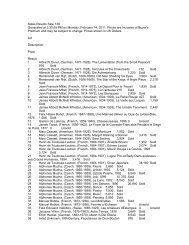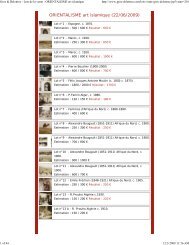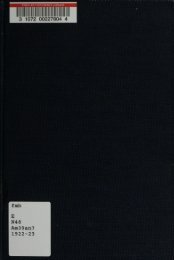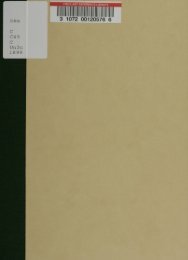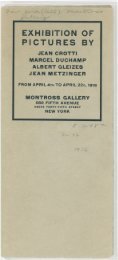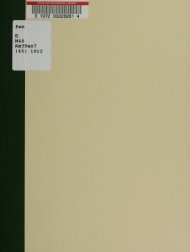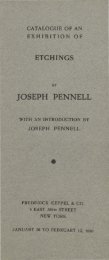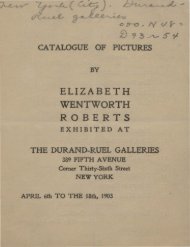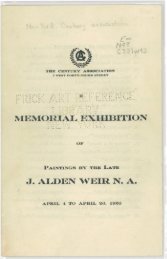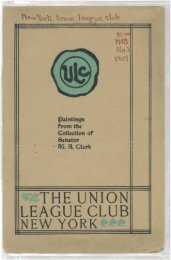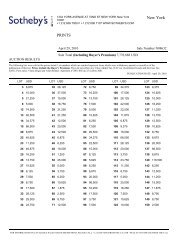Shepherds of the black-headed people - New York Art Resources ...
Shepherds of the black-headed people - New York Art Resources ...
Shepherds of the black-headed people - New York Art Resources ...
- No tags were found...
Create successful ePaper yourself
Turn your PDF publications into a flip-book with our unique Google optimized e-Paper software.
oriented towards a treelike element. 15 A related <strong>the</strong>me from Susamay be adduced. 16- 4. Two slightly different series <strong>of</strong> scenes usher in <strong>the</strong> <strong>the</strong>me<strong>of</strong> animal husbandry and milk processing, involving reed huts with arounded tip and o<strong>the</strong>r, rectangular architectural creations. 17 Thefirst series differs from <strong>the</strong> second mainly in <strong>the</strong> position <strong>of</strong> <strong>the</strong> maleperson (sitting vs. standing) and in <strong>the</strong> presence or absence <strong>of</strong>cattle protruding from <strong>the</strong> hut. The similarity <strong>of</strong> <strong>the</strong> different sealswithin one series is striking. It may legitimately be asked why suchmotifs occur in so many examples and why <strong>the</strong> individualtreatments are so close to one ano<strong>the</strong>r. The motifs are visiblyderived from representations <strong>of</strong> <strong>the</strong> Late Uruk period, where <strong>the</strong>reed hut, <strong>the</strong> cattle, and <strong>the</strong> squatting person processing milk in alarge jar with round bottom are well attested (e.g. at <strong>the</strong> Anuziggurat <strong>of</strong> Uruk 18 and in Habuba Kabira South). 19- 5. A personage, represented en face, sitting on <strong>the</strong> groundwith widely spread legs, 20 also heeds towards Late Uruk for itspredecessors. 21In addition to <strong>the</strong> above mentioned <strong>the</strong>mes which are derived from<strong>the</strong> Late Uruk tradition, <strong>the</strong> SIS 8-4 sealings also betray influences<strong>of</strong> more contemporary artistic creations such as <strong>the</strong> Glazed Steatiteglyptic. 22 Sealings like UE III: 167-169 combine standard decors <strong>of</strong><strong>the</strong> Glazed Steatite glyptic style with motifs which are developedfrom Late Uruk animal files or pigtailed women scenes.In general, a continuous development from Late Uruk imagery tothat <strong>of</strong> <strong>the</strong> Ur SIS 8-4 strata can be observed, with distinctive ED Imarkers appearing gradually but visibly. One <strong>of</strong> <strong>the</strong>se is definitely<strong>the</strong> banquet <strong>the</strong>me, an innovation <strong>of</strong> <strong>the</strong> ED period. 23 Thebanqueters drink beer and eat bread and fish. However, <strong>the</strong>involved <strong>of</strong>fering bearers, especially on UE III: 379, seem to be15 UE III: 207-214.16 Amiet 1972, Pl. 5, 471.17 First series: UE III: 45 (SIS 6-7) and 336-351; second series: 353-362.18 Boehmer 1999, Abb. 89, 90; Collon 1987, no. 12.19 Strommenger 1980; see Boehmer 1999, Abb. 117, 85 Abb. XIX.20 UE III: 42 (SIS 6?), and 268-270.21 Amiet 1972, Pl. 14, 616-618 (from Susa); compare also <strong>the</strong> figure (a longheareddaemon?) on sealings from Uruk-Eanna (Boehmer 1999, Abb. 65,66).22 See Pittman 1994.23 UE III: 373-383.24



